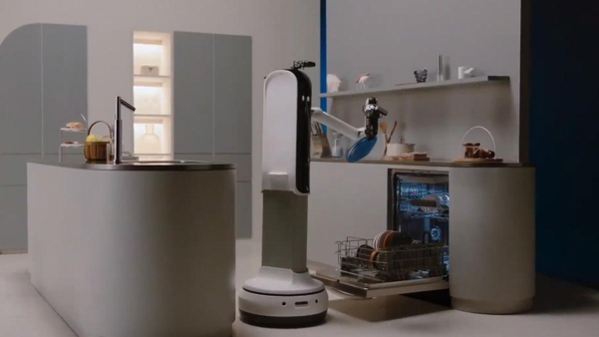Input 2021.01.29 06:00
With Samsung Electronics LG Electronics (066570)Presented a blueprint for building a’robot ecosystem’ that connects home, business, and workplace at the world’s largest consumer electronics exhibition’CES 2021′, which ended on the 14th. The competition between the two companies, starting with home appliances, is a pattern that leads to the robot market.
Samsung Electronics introduced’Samsung Bot™ Handy’ (Handy). It is a home robot that can grasp or move objects by recognizing the location or shape of an object by itself through artificial intelligence (AI). Table setting before meals and after meals can be arranged. Currently, Handy is conducting research for commercialization in the form of a prototype.
Samsung Electronics also introduced’Samsung Bot Care’. It is an upgraded version of the robot of the same name that appeared at CES 2019. Previously, it had a function to care for the elderly, but the latest version of Samsung Bot Care allows various family members to live together. In addition, the robot’Samsung Bot Serving’, a robot that supports serving food as well as ordering and payment at shopping malls and restaurants,’Samsung Bot Guide’, a consumer response robot, and’Gems’, a wearable walking assistant robot, were also introduced.

LG Electronics and Samsung Electronics are expected to clash over the robot market used in homes, restaurants, workplaces, and hospitals in the future.
Vice-Chairman Lee Jae-yong and Chairman Gwang-mo Koo have special love for the robot industry. Vice-Chairman Lee presided over a design strategy meeting at the Seoul R&D Campus in Umyeon-dong, Seocho-gu, Seoul, as his first public step since the death of late Chairman Lee Kun-hee in November last year. After the meeting at the time, Vice Chairman Lee personally inspected the prototypes of the Samsung bot series exhibited at this CES.

Hyundai Motor Group also entered the competition in the guidance robot market. Chairman Eui-sun Eui-sun’s first major merger and acquisition (M&A), the acquisition of Boston Dynamics, a robot specialist, is evaluated as giving wings to Hyundai’s robot business. Chairman Chung worked hard enough to acquire a 20% stake in Boston Dynamics. Hyundai Motor Group mainly invests in the robot industry related to mobility, logistics, and smart factories, but it is also aiming to become a global leader in the guidance and support and humanoid robot market.
Since the 25th, a service robot’DAL-e’ has been deployed at the Songpa-daero branch in Seoul. Dalyi is a guide robot developed to act as a bridge between consumers and employees. In the future, it is planned to be updated to a robot specialized in response to reflect on-site consumer requirements. Hyundai Motor Company also plans to introduce various robots in the future to build a robotic ecosystem.

The heads of these groups are paying attention to the growth of the robot market. Last year, the global robot market was estimated at 44.4 billion dollars (49 trillion won). The Hyundai Motor Group predicts that the robot market will grow at an annual average of 32% within four years, reaching 1772 billion dollars (194 trillion won) in 2025.
“It is expected that the role of robots will steadily expand with technological advances such as robotics, AI, and ICT (information and communication technology) in the future,” said Kim Yong-bok, head of the macroeconomic research department of the Bank of Korea Economic Research Institute. It is also expected to proceed faster.”
